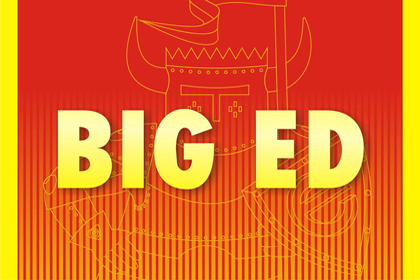
This is the Eduard, Big Ed (BIG 3514), photo etch set for the ‘German Sturmgeschütz III, Ausf. G‘ from Tamiya.
Detail set |
Tamiya |
||||
| (35 365) | Basic | ||||
| (35 372) | Schürzen | ||||
| (35 491) | Zimmerit | 35 197 | |||
| (XT 982) | Wheel mask | ||||
Source: Eduard
This is the Trumpeter 01569 kit in 1/35 scale, of the ‘Russian Heavy Tank, KV-85’.
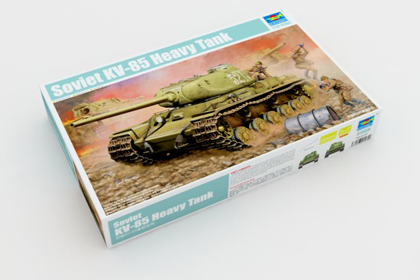
Already-high demand for the gun slowed production of the KV-85 tremendously, and only 148 were built before the KV design was replaced. The KV-85 was produced in the fall and winter of 1943-44; they were sent to the front as of September 1943, and production of the KV-85 was stopped by the spring of 1944 once the IS-2 entered full scale production.
This is the Trumpeter 00369 kit in 1/35 scale, of the ‘German Panzerjägerwagen, volume 2’.

It was the armored pursuit car replace by the earlier pusher car. That now gave the train an effective means of against Russian tanks. In this instance, a program of new construction had been planned in 1944 by German Army: 8 BP 44 armored trains.
This is the Tamiya 35 289-4200 kit in 1/35 scale, of the ‘Russian Heavy Tank, JS-2, model 1944 ChKZ’.
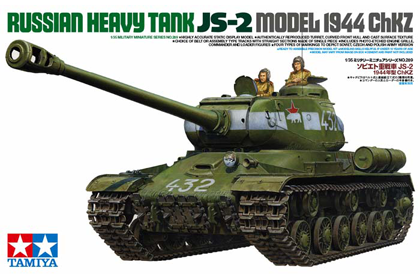
The JS-2 was produced in the Chelyabinsk Kirov factory (ChKZ), and a characteristic of the tank is it’s one piece cast rounded front. The JS-2 showed great strength in the break through of defensive positions but also in anti-tank battles. The Russian tank JS-2 played a major part which contributed to the victory of the end of the Great War.
This is the Trumpeter 00386 kit in 1/35 scale, of the ‘German Panzerjägerwagen, volume 1’.
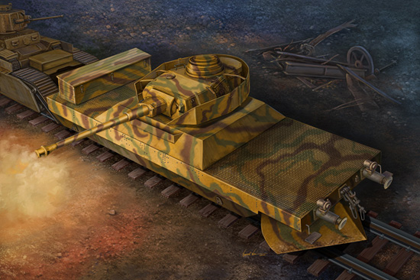
It was the armored pursuit car replace by the earlier pusher car. That now gave the train an effective means of against Russian tanks. In this instance, a program of new construction had been planned in 1944 by German Army: 8 BP 44 armored trains.
This is the Tamiya, 35 197-2600 kit in 1/35 scale, of the ‘German Sturmgeschütz III, Ausf. G – Early version’.

As it was mainly intended for close fire support for the Wehrmacht, it was used as self-propelled artillery against the opposing enemy’s strategic points. However, when the German forces encountered the Russian KV and T-34 tanks on the Eastern front, the situation abruptly changed. To cope with this Russian tank threat, the Germans were forced to upgrade their existing weapons systems. The G-type StuG III built from late 1942 onwards, used a more powerful, long barrel 75mm L/48 gun. The early G-type had a square shaped gun mantlet.
The superstructure was redesigned and an MG42 machine gun with shield, commander’s vision cupola and smoke dischargers were added. The thin steel plates, known as Schurzen (skirts) were attached to the sides of the hull beginning in the spring of 1943. The type-42 assault gun mounted a 105mm howitzer on the StugG III chassis and was developed to fulfill the StuG III’s original role of infantry support. Incorporating several minor changes, about 7,800 G-type StuG III’s were produced.
This is the Trumpeter 00356 kit in 1/35 scale, of the ‘Russian Heavy Tank, KV-1 model 1941 small turret’.
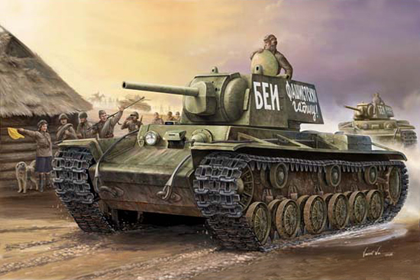
KV-1 the beginning batch quantity produces in 1942 February, at the beginning of the production model number calls the KV-1 model 1941 “small turret”, first material in KV-1 types L-11s 76.2mm of artillery; July of 1940, the heavy type in the series of KV tank production be transfered by the factory of Kirov the 100 factory production, henceforth the KV-1 that produce all changed to pack better types F-32s in function 76.2mm of artillery.
This is the Tamiya 35 216-4000 kit in 1/35 scale, of the ‘German Panzerkampfwagen VI, Tiger I, Ausf E – Early version’.

Development of the Tiger I began at the end of May 1941. The German Army Weapons Branch ordered the Henschel firm to vie with Porsche in producing a prototype. The first prototypes underwent trials on April 1942. The result of these and subsequent trial showed the superiority of the Henschel vehicle to the Porsche’s, and thus production orders were placed for it. The Henschel’s prototype had thick armor of 100mm at the front and 80mm on both sides, and the main gun was the then most potent, the 8.8cm KwK 36 L/56. The powerplant was Maybach’s HL 210 P45, yielding 650 horsepower.
Mass production started already in August 1942 with little alteration from the prototype. Starting from November 1942, air pre-cleaners were added on the rear hull plate. The mantlet was partly strengthened and “S” mine dischargers were fitted on five mounting points around the hull roof beginning from December. Moreover, a loader’s periscope was fitted from January 1943. The Tiger I produced from November 1942 to July 1943 featured these modifications, are referred to as the early production. About 200 units of these early production versions were produced.
This is the Tamiya 35 215-2600 kit in 1/35 scale, of the ‘German Panzerkampfwagen III, Ausf. L’.
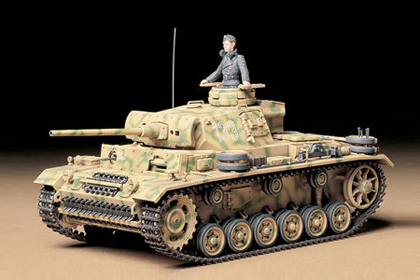
As it was manufactured at the existing tank factory, the basic performance and structure were the same as previous versions with a few modifications. Armament consisted of an improved, long barreled Kwk50 L/60 tank gun, which was effective against the Russian T34 tanks up to a range of 600m, plus two 7.92mm MG34 machine guns. The armor of the front superstructure was increased to 57mm in thickness, and a 20mm thick spaced armor was added to the gun mantlet as well, which increased the tank’s weight by 200kg.
To cope with the added weight, the suspension system was also strengthened. The powerplant was a Maybach HL120TRM, V-12, water cooled engine producing 300 horsepower. In total 635 Ausf. L’s were produced by the end of 1942, and many of them saw active service on the Eastern Front and the North African Front. Although its roll was shortly replaced by the Tiger I and the Panther, the durable chassis of the Pz.Kpfw.III was used for self-propelled guns till the end of the war.
This is the Tamiya 35 246 kit in 1/35 scale, of the ‘German 18 Ton Heavy Half-Track Famo and Tank Transporter’.
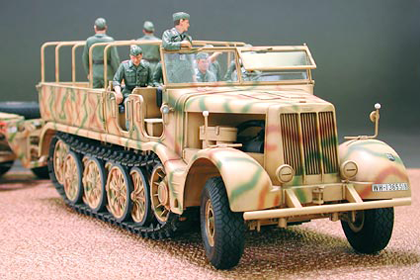
As World War II progressed, the vehicles used on the battlefields became larger and larger. When these mammoth machines broke down or became damaged, the task of bringing them back from the front lines was not an easy one. This need was especially felt by the German Wehrmacht, who were fighting on a wide range of battlegrounds: from the scorching desert of North Africa to the railroad lacking plains of Russia. Bringing damaged vehicles back from these difficult conditions was indispensable to replenishing fighting strength to the army.
The German 18 Ton Heavy Half-Track “FAMO” and Tank Transporter Sd.Ah.116 was one of the vehicles that contributed to this task. Including all variations, over 2500 18 ton half-tracks were produced by the end of the WWII. One of the major types was the tank recovery half-track, which was a mighty towing vehicle equipped with two rows of seats and a flatbed in back for the storage of equipment such as a draw-bar and spare wire rope. Tool storage compartments were found on each of the outer sides of the flatbed. In addition, the underside of a vehicle was equipped with a winch.
Its powerplant was a Maybach HL 108 12-cylinder engine, which put out 270hp. Tank transporting was conducted by either direct towing with a draw bar, or by loading the tank atop a massive trailer. Officially known as “Sd.Ah.116”, the Type 116 Trailer connected with the 18ton heavy half track, which allowed for the transportation of 22-23 ton class tanks such as the Pz.Kpfw.III, Pz.Kpfw.IV and other heavy artillery.